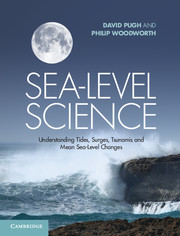Book contents
- Frontmatter
- Contents
- Preface
- List of acronyms
- List of main symbols
- Chapter 1 Introduction
- Chapter 2 Sea-level measuring systems
- Chapter 3 Tidal forces
- Chapter 4 Tidal analysis and prediction
- Chapter 5 Tidal dynamics
- Chapter 6 Shallow-water and coastal tides
- Chapter 7 Storm surges, meteotsunamis and other meteorological effects on sea level
- Chapter 8 Tsunamis
- Chapter 9 Spatial variations in sea level
- Chapter 10 Mean sea-level changes in time
- Chapter 11 Sea-level changes in time to do with the solid Earth
- Chapter 12 Sea-level applications
- Chapter 13 Sea level and life
- Appendix A Basic hydrostatic and hydrodynamic equations
- Appendix B Currents
- Appendix C High and low water times and heights from harmonic constituents
- Appendix D Theoretical tidal dynamics
- Appendix E Legal definitions in the coastal zone
- Glossary
- Index
- References
Chapter 6 - Shallow-water and coastal tides
Published online by Cambridge University Press: 05 May 2014
- Frontmatter
- Contents
- Preface
- List of acronyms
- List of main symbols
- Chapter 1 Introduction
- Chapter 2 Sea-level measuring systems
- Chapter 3 Tidal forces
- Chapter 4 Tidal analysis and prediction
- Chapter 5 Tidal dynamics
- Chapter 6 Shallow-water and coastal tides
- Chapter 7 Storm surges, meteotsunamis and other meteorological effects on sea level
- Chapter 8 Tsunamis
- Chapter 9 Spatial variations in sea level
- Chapter 10 Mean sea-level changes in time
- Chapter 11 Sea-level changes in time to do with the solid Earth
- Chapter 12 Sea-level applications
- Chapter 13 Sea level and life
- Appendix A Basic hydrostatic and hydrodynamic equations
- Appendix B Currents
- Appendix C High and low water times and heights from harmonic constituents
- Appendix D Theoretical tidal dynamics
- Appendix E Legal definitions in the coastal zone
- Glossary
- Index
- References
Summary
‘. . . I don’t see the good of the tides. What’s the good of a sea if it’s going to be mud in a few hours.’ ‘It’s like breathing,’ said Titty. ‘Up and down. Up and down. It makes everything alive.’
Arthur Ransome, Secret WaterIn the previous chapter we showed how the amplitudes of the tidal waves generated in the deep oceans increase when they spread onto the shallow surrounding continental shelves. In this chapter we consider the further and more extreme distortions that occur as the tidal waves propagate into the even shallower coastal waters and rivers. The behaviour of these distorted tides is very important for near-shore human activities such as recreational pursuits and coastal navigation. The distortions are also important for geological and biological processes in the coastal zone.
Introduction: some observations
Sea-level records from shallow-water locations normally show that the interval from low to high water is shorter than the interval from high to low water: the rise time is more rapid than the fall. Offshore the flood currents are stronger than the ebb currents. High waters occur earlier than simple predictions, and low waters are later.
- Type
- Chapter
- Information
- Sea-Level ScienceUnderstanding Tides, Surges, Tsunamis and Mean Sea-Level Changes, pp. 133 - 154Publisher: Cambridge University PressPrint publication year: 2014



